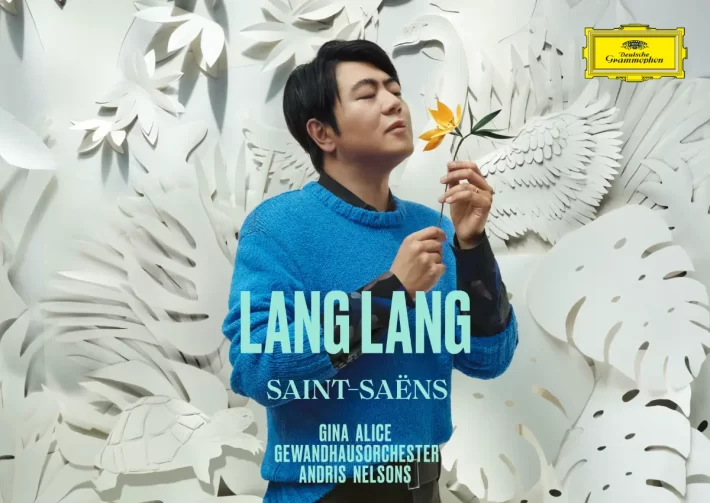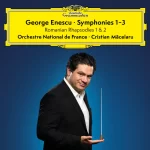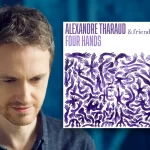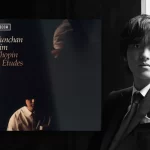This offering of 14 works, while generous, is a tad misleading given the “Saint Saëns” title: of course, there are the well-known Carnivals of Animals and the Second Piano Concerto (with Gewandhausorchester under Andris Nelsons) but Lang Lang widens the scope to Ravel, Debussy, and Fauré. Of interesting note is his first feature of several female French composers including Boulanger, Tailleferre, and Farrenc.
The popular Carnival of the Animals is a sure bet for an immersive start. Lang Lang and his wife Gina Alice, as collaborative soloists, show strong musical synchronicity throughout. Although I listened to the entire set with much joy, there were particular highlights. One is the Lion’s March (track 2) with pomp and circumstance aplenty, thanks to the enthusiastic Gewandhausorchester strings. Where the imagination truly comes alive, though, is in the low octave passages that evoke the animal’s roar. The Jackasses (track 4) have impressive agility while the Tortoises (track 5), in light of all the vivacious action prior, offer a soothing and most appropriate moment of calm. I felt the Aquarium (track 8) was the standout movement with its delicate sense of mystery. The faultlessly fluid and undulating piano passages really sparkle against the orchestra’s nicely managed sostenuto.
With some excellent recordings of the G minor Piano Concerto out there, including one from Alexander Kantorow/Tapiola Sinfonietta that I reviewed in 2022, the bar is set pretty high. I wouldn’t be surprised if Lang Lang’s virtuosity played well into the work’s explosive drama (which it does convincingly in the outer movements), so my anticipation actually lay in the potentiality for nuance. There’s no better litmus test for this than the Allegro Scherzando (track 17). Indeed, there are touches of elegance and whispery flourishes, but the overall interpretation is extroverted, and part of it has to do with the ensemble. The opening timpani strikes, for instance, when compared to those of the Tapiola players introduce more aggressive and perhaps pushy energy. And where soloists are concerned, Kantorow’s articulation is even and drier across the board, giving the music a ballet-quality; Lang Lang leans more heavily into the downbeats for a heavier but arguably more jovial take.
There are several 4-hands works presented in which Lang Lang again collaborates with Gina Alice. It is here that we find the most finesse and subtlety, especially in Debussy’s Petite Suite—which I daresay was my favorite work on the album. The tenderness and innocence of En Bateau (track 20) comes through the fine shading and mellow quality of the piano dynamics that shine particularly in the lovely recapitulation. The pianists’ sense of joy is evident in the Cortège (track 21), whose intervallic passages are delightfully pristine and light. Their responsiveness to Debussy’s colors has a refined sensitivity which blossoms into a jubilant finale via a well-structured buildup. The Menuet that follows has some gorgeous communication and dovetailing of melodies across parts. These melodies, I found, were not merely fluid and lyrical but also have an alluring hint of the ethereal. Humor and caprice find their rightful places in the Ballet (track 23) but maybe what is most refreshing about the performance is its unfailing sprightliness.
As for the shorter works, the Tailleferre Etude (track 28) has moments of Lisztian drama and bravado. I did find the element of melancholy a bit overdone and maudlin, at least compositionally. However, Lang Lang plays into this mood effectively and makes the most of the flashy runs where they appear. On the opposite end of the spectrum (and a work I enjoyed much more) is Lili Boulanger’s D’un jardin clair (track 32), which harkens back to Impressionistic creativity through its parallel harmonies and vivid tonalities. The pianist demonstrates his capacity for otherworldly and breathtaking transparency of sound that I honestly wished I could have heard even more of.
The photos aplenty in the booklet are fortunately complemented by a forward from Lang Lang which lends some context to the programming, especially outside of Saint Saëns. It is the liner notes, however, that deliver clear insight into his thoughtful selection of pieces, reflecting the music he encountered in his youth. Instead of a dry musical analysis, the notes provide meaningful commentary on the collaborative process with Nelsons and Gina Alice that adds perspective to the overall strong performances. A warmly recommended listen.

Saint Saëns
Lang Lang – Piano
Gina Alice – Piano
Gewandhausorchester
Andris Nelsons – Conductor
Deutsche Grammophon, CD 4859224
Related Albums
Saint-Saëns Complete Piano Concertos – Rogé & Dutoit | Saint-Saëns Complete Piano Concertos – Collard & Previn | Saint-Saëns Carnival of the Animals – Pappano | Saint-Saëns – Carnival of the Animals – Barenboim & Argerich
Included with an Apple Music subscription:
Latest Classical Music Posts
- Review: The Vienna Recital – Yuja Wang, Piano
- Editor’s Choice: The Best New Classical Music Albums, May 2024
- Review: Enescu – Symphonies Nos. 1-3 & 2 Romanian Rhapsodies – Cristian Mǎcelaru
- Review: “Four Hands” – Alexandre Tharaud
- Review: Chopin – Études – Yunchan Lim
- Review: Britten – Violin Concerto, Chamber Works – Isabelle Faust
Read more classical music reviews or visit The Classic Review Amazon store
Follow Us and Comment:
Get our periodic classical music newsletter with our recent reviews, news and beginners guides.
We respect your privacy.


















